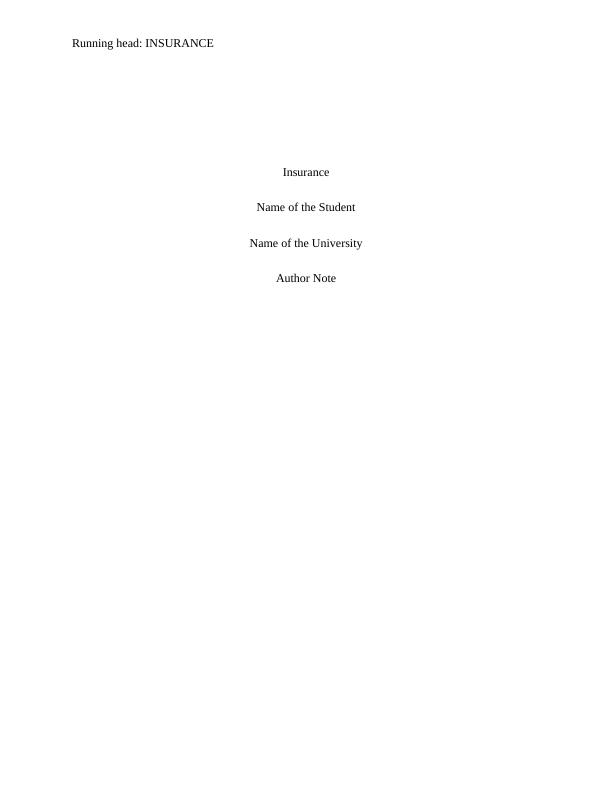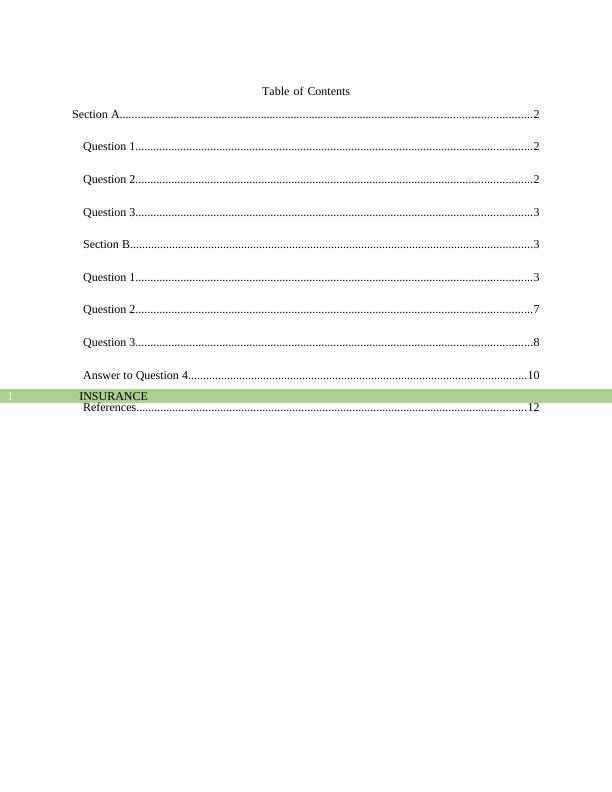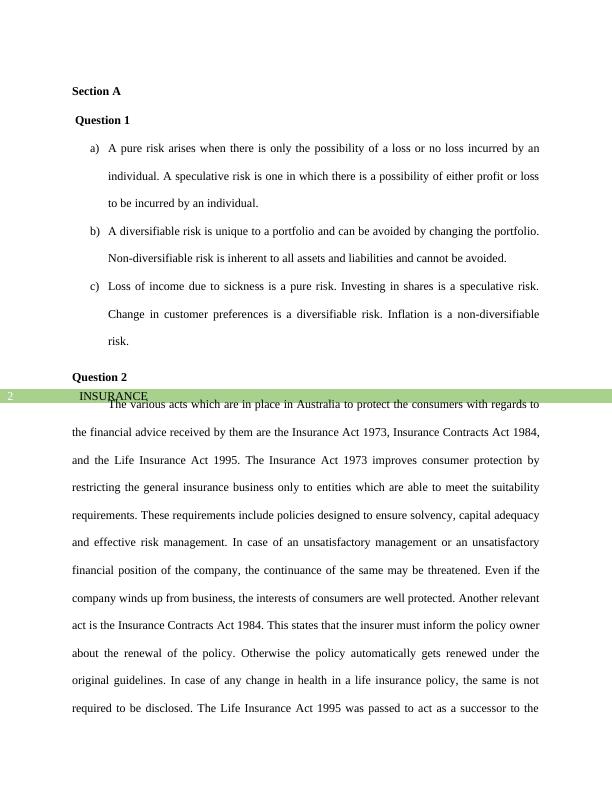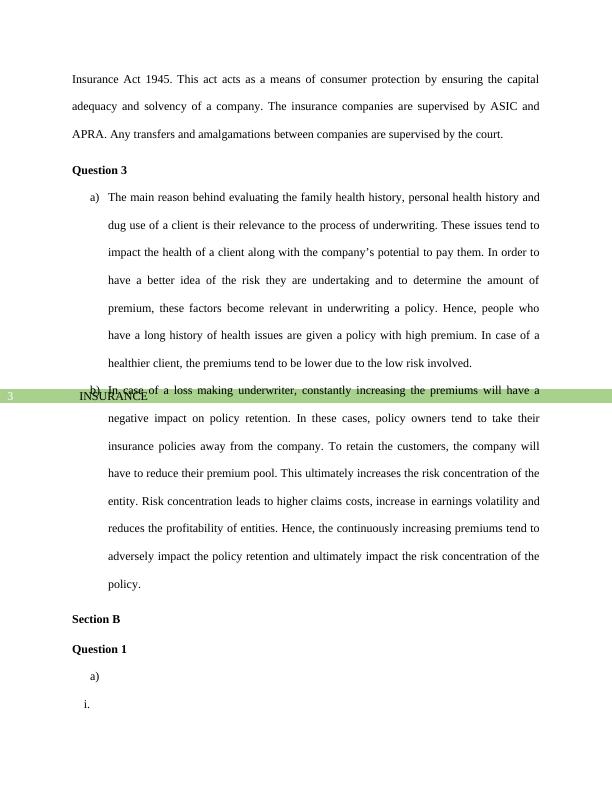Insurance Pure Risk Cover
Added on 2022-08-14
14 Pages3465 Words14 Views
Running head: INSURANCE
Insurance
Name of the Student
Name of the University
Author Note
Insurance
Name of the Student
Name of the University
Author Note

INSURANCE1
Table of Contents
Section A.........................................................................................................................................2
Question 1....................................................................................................................................2
Question 2....................................................................................................................................2
Question 3....................................................................................................................................3
Section B......................................................................................................................................3
Question 1....................................................................................................................................3
Question 2....................................................................................................................................7
Question 3....................................................................................................................................8
Answer to Question 4.................................................................................................................10
References..................................................................................................................................12
Table of Contents
Section A.........................................................................................................................................2
Question 1....................................................................................................................................2
Question 2....................................................................................................................................2
Question 3....................................................................................................................................3
Section B......................................................................................................................................3
Question 1....................................................................................................................................3
Question 2....................................................................................................................................7
Question 3....................................................................................................................................8
Answer to Question 4.................................................................................................................10
References..................................................................................................................................12

INSURANCE2
Section A
Question 1
a) A pure risk arises when there is only the possibility of a loss or no loss incurred by an
individual. A speculative risk is one in which there is a possibility of either profit or loss
to be incurred by an individual.
b) A diversifiable risk is unique to a portfolio and can be avoided by changing the portfolio.
Non-diversifiable risk is inherent to all assets and liabilities and cannot be avoided.
c) Loss of income due to sickness is a pure risk. Investing in shares is a speculative risk.
Change in customer preferences is a diversifiable risk. Inflation is a non-diversifiable
risk.
Question 2
The various acts which are in place in Australia to protect the consumers with regards to
the financial advice received by them are the Insurance Act 1973, Insurance Contracts Act 1984,
and the Life Insurance Act 1995. The Insurance Act 1973 improves consumer protection by
restricting the general insurance business only to entities which are able to meet the suitability
requirements. These requirements include policies designed to ensure solvency, capital adequacy
and effective risk management. In case of an unsatisfactory management or an unsatisfactory
financial position of the company, the continuance of the same may be threatened. Even if the
company winds up from business, the interests of consumers are well protected. Another relevant
act is the Insurance Contracts Act 1984. This states that the insurer must inform the policy owner
about the renewal of the policy. Otherwise the policy automatically gets renewed under the
original guidelines. In case of any change in health in a life insurance policy, the same is not
required to be disclosed. The Life Insurance Act 1995 was passed to act as a successor to the
Section A
Question 1
a) A pure risk arises when there is only the possibility of a loss or no loss incurred by an
individual. A speculative risk is one in which there is a possibility of either profit or loss
to be incurred by an individual.
b) A diversifiable risk is unique to a portfolio and can be avoided by changing the portfolio.
Non-diversifiable risk is inherent to all assets and liabilities and cannot be avoided.
c) Loss of income due to sickness is a pure risk. Investing in shares is a speculative risk.
Change in customer preferences is a diversifiable risk. Inflation is a non-diversifiable
risk.
Question 2
The various acts which are in place in Australia to protect the consumers with regards to
the financial advice received by them are the Insurance Act 1973, Insurance Contracts Act 1984,
and the Life Insurance Act 1995. The Insurance Act 1973 improves consumer protection by
restricting the general insurance business only to entities which are able to meet the suitability
requirements. These requirements include policies designed to ensure solvency, capital adequacy
and effective risk management. In case of an unsatisfactory management or an unsatisfactory
financial position of the company, the continuance of the same may be threatened. Even if the
company winds up from business, the interests of consumers are well protected. Another relevant
act is the Insurance Contracts Act 1984. This states that the insurer must inform the policy owner
about the renewal of the policy. Otherwise the policy automatically gets renewed under the
original guidelines. In case of any change in health in a life insurance policy, the same is not
required to be disclosed. The Life Insurance Act 1995 was passed to act as a successor to the

INSURANCE3
Insurance Act 1945. This act acts as a means of consumer protection by ensuring the capital
adequacy and solvency of a company. The insurance companies are supervised by ASIC and
APRA. Any transfers and amalgamations between companies are supervised by the court.
Question 3
a) The main reason behind evaluating the family health history, personal health history and
dug use of a client is their relevance to the process of underwriting. These issues tend to
impact the health of a client along with the company’s potential to pay them. In order to
have a better idea of the risk they are undertaking and to determine the amount of
premium, these factors become relevant in underwriting a policy. Hence, people who
have a long history of health issues are given a policy with high premium. In case of a
healthier client, the premiums tend to be lower due to the low risk involved.
b) In case of a loss making underwriter, constantly increasing the premiums will have a
negative impact on policy retention. In these cases, policy owners tend to take their
insurance policies away from the company. To retain the customers, the company will
have to reduce their premium pool. This ultimately increases the risk concentration of the
entity. Risk concentration leads to higher claims costs, increase in earnings volatility and
reduces the profitability of entities. Hence, the continuously increasing premiums tend to
adversely impact the policy retention and ultimately impact the risk concentration of the
policy.
Section B
Question 1
a)
i.
Insurance Act 1945. This act acts as a means of consumer protection by ensuring the capital
adequacy and solvency of a company. The insurance companies are supervised by ASIC and
APRA. Any transfers and amalgamations between companies are supervised by the court.
Question 3
a) The main reason behind evaluating the family health history, personal health history and
dug use of a client is their relevance to the process of underwriting. These issues tend to
impact the health of a client along with the company’s potential to pay them. In order to
have a better idea of the risk they are undertaking and to determine the amount of
premium, these factors become relevant in underwriting a policy. Hence, people who
have a long history of health issues are given a policy with high premium. In case of a
healthier client, the premiums tend to be lower due to the low risk involved.
b) In case of a loss making underwriter, constantly increasing the premiums will have a
negative impact on policy retention. In these cases, policy owners tend to take their
insurance policies away from the company. To retain the customers, the company will
have to reduce their premium pool. This ultimately increases the risk concentration of the
entity. Risk concentration leads to higher claims costs, increase in earnings volatility and
reduces the profitability of entities. Hence, the continuously increasing premiums tend to
adversely impact the policy retention and ultimately impact the risk concentration of the
policy.
Section B
Question 1
a)
i.

End of preview
Want to access all the pages? Upload your documents or become a member.
Related Documents
Assignment on Strategic Management Accountinglg...
|14
|3574
|29
Retirement, Investments, and Insurancelg...
|13
|3049
|29
